|
To
hasten the progress
of prolonged and difficult labor, the midwives of the earliest times
often
felt the desire of being able to hold the head of the child between
their
hands. However, the human hands are too thick and large.
Thinner
and slimmer, the obstetrical forceps were used, which are in reality
nothing
else than a pair of iron hands. |
|
The
Secret of the Obstetrical
Forceps
In 1813 by a
fortunate
accident, several
obstetrical instuments were uncovered at the estate of Woodham Mortimer
Hall, near Malden, in Essex, which was owned by Dr Chamberlen (third
generation),
until 1715. From the fashion of these instruments may be traced
the
development of the Chamberlen's forceps. The obstetrical forceps was
devised
on the late 1500 A.D. to the beginning of the 1600 by a member of the
Chamberlen
family. The forceps was kept a family secret for four
generations.
Little was known of the forceps up to the second quarter of the 18th
Century.
No method other
than the
podalic version
(insertion of the operators hand inside the uterus and grab one or both
feet of the baby and pull the infant out), was available
mechanically
to assist the delivery of a living child. So many babies were
lost
or maimed and countless mothers perished from exhaustion, hemorrhage
and
infection before the advent of the obstetrical forceps. The
forceps
continue to save babies and mothers up to the present time. It
must
be one of the most important inventions in medicine.
|
The Progress of the Chamberlen Forceps
|

|
A
simple lever |

|
Double blade connected
together with a
riveted joint, and scissor like handles.
|

|
Double blades
with hooked
handles in which
the joint is formed by a loose pivot on one blade, and a hole in the
other
to receive it.
|

|
The
most advanced
of the
Chamberlen's forceps.
Both blades had a hole at the joint through which is passed a string to
connect the blades. The string is tied around the joint to make
it
fixed. |
| The
Chamberlen forceps was a
straight, short
and have the the cephalic curve only. It is approximately 28 cm
(11
inches) long. Levret of France in 1747 and Smellie of England in
1751 independently of one another added the pelvic curve to
the
obstetrical
forceps. |
|
The
pelvic
curve of the
forceps.
Designed to accomodate the
maternal pelvic curve. |
The cephalic curve of
the forceps.
Formed to embrace the fetal head. |
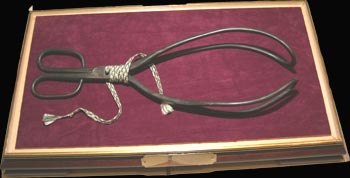
|
Chamberlen
Forceps Replica
A
cased facsimile
of the most advanced of the Chamberlen forceps. A perfectly cast
from the third pair of the original Chamberlen forceps held at
the Royal College of Obstetricians & Gynecologists and is one of a
limited edition of 250.
|
|
Obstetrical
Forceps Locks
There are several
system where the
obstetrical
forceps lock the two blades. Illustrated
below are the major
locks to permit
ready articulation and hold the blades together. |
English
Lock
Introduced in 1752
Consists of a socket upon each
branch into
which fits the shank of the other half of instrument. The notches in
each
stem fit together to lock the instrument. |
French Lock
Introduced 1747
A revolving thumb lock that is
inserted into a
slot, then turned to secure the blades into position. |
Siebold's
Lock
Introduced 1804
A modification of the
French lock.
A pivot is screwed into the shank of the left branch, while the right
presents
an opening which can be adjusted to it, the screw being tightened after
articulation. |
|
German Lock
The shank of the left branch
bearing a pivot with
a broad, flat head, while the right is provided with a notch which
corresponds
to the pivot. |
|
The
precursor of the obstetrical
forceps: Roonhuysen Lever
|
Roonhuysen
Lever
c
1750-1790
Roonhuysen introduced
the first lever in obstetrics in the late 17th Century. It is
also
called the vectis or the extractor. The lever consisted of a flat
piece of iron, bent into a slight curve at both ends, and wrapped it
with
a soft leather so as to be gentle with the fetal and maternal
skin.
The instrument was used to displace a face presentation or dislodge an
impacted fetal head from the pelvis. Unplated steel, 25 x 2.5 cm
(9 3/4") |

|
The Vectis
A single blade to extract a living
child.
It is used as a lever or a tractor or an artificial right hand. It is
also called the lever or extractor
Three
of
four fingers of the left hand act as antagonist. The use of the
vectis is illustrated.
|
Lowder's
Vectis
Circa 1860s
The vectis is
hinged.
Unplated steel with ebony handle. 30 cm (11 3/4") in dimensions.
|
Different
Kinds of Vectis
|
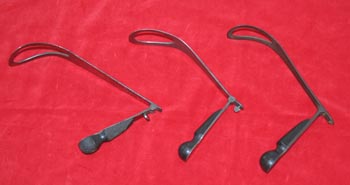 |

|
| Folding vectis
with different joints |
Non hinged vectis |
Short and Long Straight Forceps
Like
the Chamberlen forceps, both pairs of forceps
have the cephalic curve only, but no pelvic curve. The short
forceps have smooth ebony handles, English lock unplated steel
blades. The long forceps is the Denman's forceps. It has
ribbed ebony handles with notched end, unplated steel blades with
English lock.
|
The Levret's Forceps Type III
|
Levret's
Forceps
c 1750s
In
1747, Andre Levret of France applied the first pelvic curve on
the
obstetrical forceps. He also introduced the French lock to hold
the
blades together. The fetal side of the blades are grooved. Unplated
steel
with hooked handles. |
Smellie's
Forceps
c 1800s
Introduced by English
Surgeon William Smellie in 1752. It contained the most advanced
obstetrical
lock, the English lock. Smellie together with Andre Levret added
the pelvic curve to the blades of the forceps. Unplated steel with
ebony
handle. The notches on the handle are to be bound together by a
tape
to hold the blades together. See Bennion, pg 119, No 7, Ch
6. |
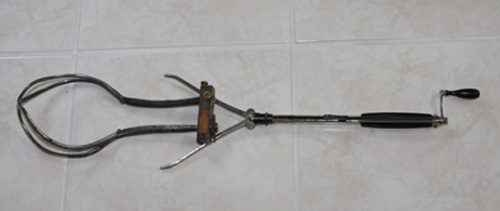
|
Hamon's
Forceps with Mechanical Tractors (Late Model)
Circa 1877
L. Hamond constructed a more
complicated mechanical tractor than his earlier model used with his
retroceps. The two crutches (missing) pressed in the genitocrural
fold and a long screw with a cranked handle.
See pg 155 Fig. 11.14 The
Obstetricians Armamentarium, Brian Hibbard, Norman Publishing, 2000.
|
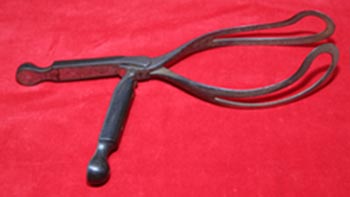 |
Hamilton
Forceps
Circa 1792
It is a
short forceps
with a pelvic curve and an English lock. The right hand blade has
a hinge between the handle and blade, by which it is easily
introduced
while the patient lies on her left side. It has a distinctive
upward
curve to both fenestrated blades. The
value of the hinge was unknown. It may just be the craze of the
time.
Unplated steel with ebony handles. |

|
Orme-Lowder's
Forceps
Circa: 1782
Short,
straight forceps without
the pelvic curve.
It has broad blades, wide parting shanks. Designed by David Orme, M.D.
of Edinburgh, and William Lowder, M.D. of Southhampton. 28 cm (10 3/4")
Das p220 Fig 244. |
|
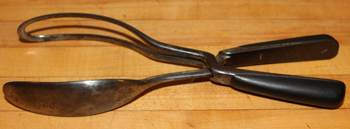
|
Spoon
and Fenestrated Blade Forceps.
With
the male spoon, and female fenestrated interlocking blades. Unplated
steel with ebony handles.
|

|
Dubois'
Forceps
Introduced
in 1791
Long
and heavy forceps with
detachable wooden
handles. Designed by father and son: Antoine and Paul
Dubois.
They modified the Levret's forceps. 48 1/2 cm ( 19 ") Hibbard p64.
Fig.
5.8 |
 |
Antoine
Dubois's Forceps
Introduced in 1850
All metal
long forceps. On one
handle, a sharp
point with olive screw cap. 48 1/2 cm
(19")
Hibbard pg 64
Fig 5.7 |
Pajot's
(Jointed) Forceps
Circa: 1866
Jointed on
the shanks, detachable
curved ends
of handles to expose sharp points. All unplated steel measuring
48
cm ( 14 1/2"). Das p421 Fig 511-2 |
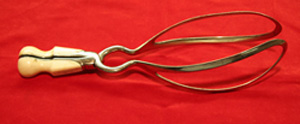 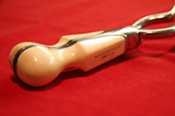
|
Ivory Handled
Hopkin's OB forceps
Circa
1833
Inscribed
on handles Dr Hopkins impd forceps
on one handle, Millikin 301 Strand London on the other. On one of the
shanks, marked: Univ. College, Liverpool
|
  |
Ivory
Handled Naegele's OB forceps
Circa
Mid 1800
Checkered ivory handles with
upturned knobs at the end. Unplated steel blades marked: J. GRAY &
Sons, Sheffield.
|
 |
Levret's
Modified Forceps
Circa:
1850s
Unplated
steel, hooked handles and
French lock.
Fetal side of blades not grooved. 48 1/2 cm (19") in length. |

|
J.D.
Busch's Forceps
Introduced
in 1798
In 1793
Johann Busch introduced
the finger rest.
Ebony handle with finger rest for traction. 36 cm ( 14 ")
Hibbard,
p73, fig 5.23 |

|
Hodge's
Forceps
Circa 1833
Designed
byDr. Hugh L. Hodge of
Pennsylvania.
It has an ovoid blades, parallel shanks, increased pelvic curve, and a
Siebold's lock. Unplated steel. 1987 Wilbur, M.Ds,, Antique Med.
Instr. p103
|
 |
Simpson
Short Forceps
Circa 1848
Only 4 cm
(2 1/2 ") long handles,
lined with a
very thick and convex layer of checkered ebony; no palm rest and no
finger
rest, and no pelvic curve. Unplated steel, 24 cm (9
3/4")
in length.
Fig 437.
Das 1929 |
Hamon's Forceps
Circa
1864
Often called "retroceps'
forceps, meaning behind the head. The
blades were placed behind the head and it articulates on a common
transverse handle. The right shank revolves. It serves more
like a lever and never had a practical usage.
|
|
Vacher's
Forceps
Introduced in
1873. A short folding
forceps with smooth ebony handles. Fig 534,535 p447 Das 1929
|
|
Elliot
Forceps
Circa 1858
To avoid compression to the
fetal head, the Elliot forceps provides a sliding pivot on the handles to
keep it at a desired distance apart. Ebony handle, uplated steel.
|

|

|
Hale's
Forceps
Circa: 1880
Short
forceps with German
lock. Ebony
handle, unplated steel. 27 cm ( 10 1/2")
|

|
Sawyer's
Short Forceps
Circa: 1876
Unplated
steel, ebony handle, and
metal hooked
ends. Marked Shepard and Dudley. 25 cm (9 3/4") Tiemann
p537 Fig 3741 |
Lusk's
Tarnier's Axis
Traction Forceps
Circa 1880s
Traction
on the handle guides the
operator
the precise direction of the pelvic axis. Unplated steel blades,
horn covered handles, double connecting rods attached to the side of
the
blades. The traction device has an ebony handle. Bar marked
Collin,
Brevete SDGD. Fig 3779, Tiemann.
|
Smith's
Forceps
Circa 1875
Unplated
steel with finely ribbed
removable
handles. It has hooked ends and Siebold's lock.
Marked
Mathieu A. Paris. Length: 47 cm. 1987 Keith Wilbur, Antique Medical Instr. p104.
|

|
Bedford's
Forceps
Circa: 1878
Wooden
handle with ring finger
rest and German
lock. Unplated steel. Marked Shepard and Dudley. 30 cm. (15
1/4") Tiemann p540 Fig 3762 |
Noncrossed
or Parallel Forceps
Circa: Mid
1800s
Consists
of two parallel
forceps held together
by pin and socket cross bar. The idea is to apply traction to the
fetal head without compression..All metal unplated steel. 42 x 18
cm . |
Steifenhofer Parallel Forceps
Plated
steel parallel forceps similar to
Boerma. The rib handles are interconnected with a round joint at
the base; they have small protrusions on the ends for grip; hallmarked
with a crowned caduceus. 10 5/8" long, 1907 forceps
described in Das p683.
|
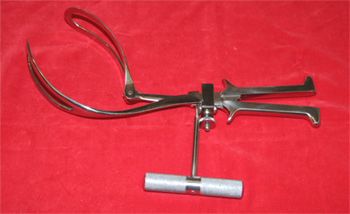
|
Barton's
Forceps
A
rotational forceps introduced in 1925 by Lyman Barton of New York . The
blades join the shanks at an angle. One of the blades is hinged. This
ob forceps has a
sliding lock with a cross
bar handle axis-traction attachment. The handle have a finger rest.
|

|
Kielland
Forceps
A rotational forceps with
a sliding lock. Stainless steel
|
Moolgauker's Forceps
Another
rotational ob forceps, supposedly
an
upgrade to the Kielland's forceps. It has a sliding
shanks with a lock. The handles have a finger rest and a spacer
that can be adjusted with a winged knot. The blades have 4 round
fenestrations on each side.
|
Return to Top

All statements in
this web page
regarding date, age, and origin are statements of opinion. All
photos
and materials on this web page are protected by copyright laws.
Please
obtain direct permission from to
use any and all materials on this site, including photographs and
drawings. to
use any and all materials on this site, including photographs and
drawings.
|
 Main
Main 

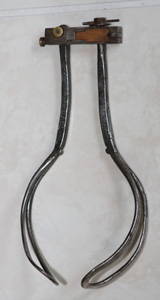






















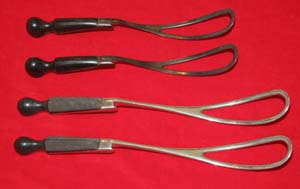
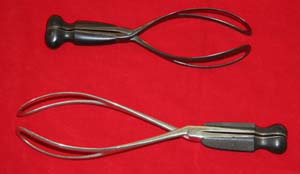






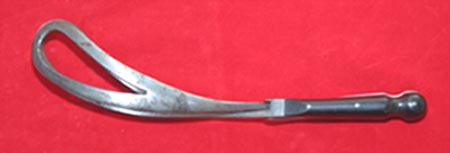


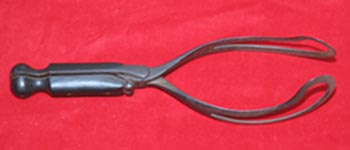
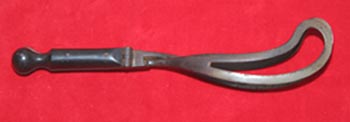

















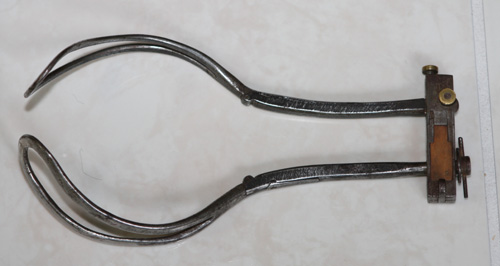
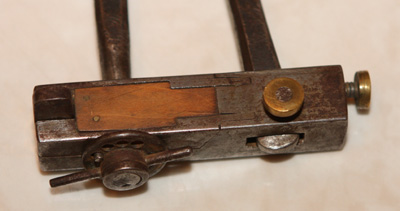
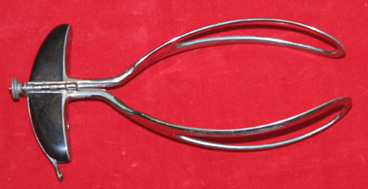
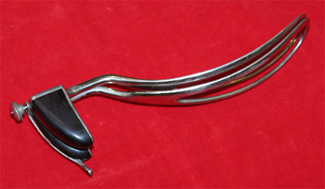












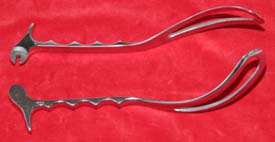
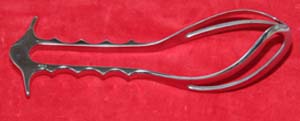





 to
use any and all materials on this site, including photographs and
drawings.
to
use any and all materials on this site, including photographs and
drawings.